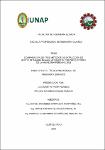| dc.contributor.advisor | Carrasco Montañez, Daniel Diomedes | |
| dc.contributor.advisor | Suárez Rumiche, Jorge Antonio | |
| dc.contributor.advisor | Echevarría Ordoñez de Araujo, Maritza | |
| dc.contributor.author | Paima Pizango, Luis Martin | |
| dc.contributor.author | Camus Parano, Franco Marcelo | |
| dc.date.accessioned | 2024-05-28T18:13:51Z | |
| dc.date.available | 2024-05-28T18:13:51Z | |
| dc.date.issued | 2024 | |
| dc.identifier.other | 665.0282 P17 2024 | |
| dc.identifier.uri | https://hdl.handle.net/20.500.12737/10160 | |
| dc.description.abstract | This study investigates three methods of oil extraction from Mauritia flexuosa used by producers in the Peruvian Amazon, using three varieties of aguaje: Color, Amarillo and Shambo Azul. The study was descriptive-comparative, the first method consisted of pressing the flour obtained from the aguaje pulp, bagasse and husk (DSMP); the second method consisted of pressing the aguaje pulp flour (DSP); for the third method the procedure consisted of bringing the wet aguaje pulp to boiling for a period of 30 minutes (DC). The findings reveal that the Mauritia flexuosa varieties with the highest oil content irrespective of the method employed are Color and Amarillo, with 26.7% and 26.03%e for the DSMP method; 18.3%e and 18% for the DSP method; 17.4% and 15% in the DC method. The method of pressing the flour obtained from the pulp, bagasse and husk of the aguaje (DSMP) presented the highest yield in the three varieties, for the varieties Color and Amarillo resulted in an average of 28% and for the Shambo Azul 19.7%. In conclusion, the extraction method by which the highest oil yield can be obtained from Mauritia flexuosa is the pressing method of pulp meal, bagasse and husk. And either the Color or Amarillo varieties can be used as both have good yields. | en_US |
| dc.description.abstract | El presente estudio investiga tres métodos de extracción de aceite de Mauritia flexuosa empleados por productores de la Amazonía peruana, utilizando tres variedades de aguaje: Color, Amarillo y Shambo Azul. El estudio fue del tipo descriptivo-comparativo, el primer método consistió en prensar la harina obtenida a partir de la pulpa, bagazo y cascarilla del aguaje (DSMP); el segundo método consistió en prensar la harina de pulpa de aguaje (DSP); para el procedimiento del tercer método consistió en llevar la pulpa húmeda de aguaje a ebullición durante un período de 30 minutos (DC). Los hallazgos revelan que las variedades de Mauritia flexuosa con más contenido de aceite independientemente del método empleado son las de Color y Amarillo, 26.7% y 26.03 para el método DSMP; 18.3% y 18% para el método DSP; 17.4% y 15% en el método DC. El método de prensado de la harina que se obtuvo a partir de la pulpa, bagazo y cascarilla del aguaje (DSMP) presentó el más alto rendimiento en las tres variedades, para las variedades Color y Amarillo resultó un promedio de 28% y para el Shambo Azul19.7%. En conclusión, el método de extracción por el cual se puede obtener un mayor rendimiento de aceite de Mauritia flexuosa es el método de prensado de harina de pulpa, bagazo y cascarilla. Y se puede emplear las variedades Color o Amarillo ya que ambos presentan buen rendimiento. | es_PE |
| dc.format | application/pdf | es_PE |
| dc.language.iso | spa | es_PE |
| dc.publisher | Universidad Nacional de la Amazonía Peruana | es_PE |
| dc.rights | info:eu-repo/semantics/openAccess | * |
| dc.rights.uri | https://creativecommons.org/licenses/by/4.0/ | * |
| dc.subject | Extracción | es_PE |
| dc.subject | Métodos | es_PE |
| dc.subject | Aceites vegetales | es_PE |
| dc.subject | Aguaje | es_PE |
| dc.subject | Mauritia flexuosa | es_PE |
| dc.title | Comparación de tres métodos de extracción de aceite de Mauritia flexuosa aplicados por productores de la Amazonía Peruana 2023 | es_PE |
| dc.type | info:eu-repo/semantics/bachelorThesis | es_PE |
| thesis.degree.discipline | Ingeniería Química | es_PE |
| thesis.degree.grantor | Universidad Nacional de la Amazonía Peruana. Facultad de Ingeniería Química | es_PE |
| thesis.degree.name | Ingeniero(a) Químico(a) | es_PE |
| dc.subject.ocde | https://purl.org/pe-repo/ocde/ford#2.04.01 | es_PE |
| renati.author.dni | 70880559 | |
| renati.author.dni | 72810207 | |
| renati.advisor.orcid | https://orcid.org/0000-0002-2317-3911 | |
| renati.advisor.orcid | https://orcid.org/0000-0001-6823-8734 | |
| renati.advisor.orcid | https://orcid.org/0000-0001-6763-396X | |
| renati.advisor.dni | 05339922 | |
| renati.advisor.dni | 05393774 | |
| renati.advisor.dni | 02583077 | |
| renati.type | https://purl.org/pe-repo/renati/type#tesis | es_PE |
| renati.discipline | 531026 | es_PE |
| renati.level | https://purl.org/pe-repo/renati/level#tituloProfesional | es_PE |
| renati.juror | Rojas Amasifuen, Juan Manuel | |
| renati.juror | García Pérez, Víctor | |
| renati.juror | Saldaña Ramírez, Robinson | |
| dc.publisher.country | PE | es_PE |





